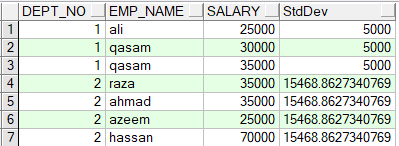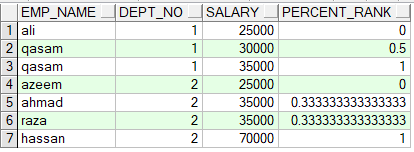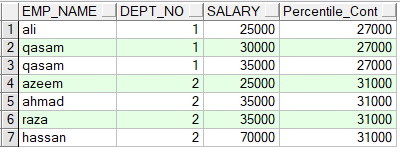Note: Document very important for Database Development.
Analytical Functions:
The function which are used to “Over Clause” is known as Analytical function. As shown in Examples.These function are used to analyses the records.Some analytical functions are following.
·
Variance Function
·
Var_samp Function
·
Var_Pop Function
·
STDDEV
·
STDDEV_Samp
·
STDDEV_Pop
·
Row_Number Function
·
Ratio_To_Report Function
·
Percent_Rank Function
·
Percentile_Count Function
·
NTILE Function
·
Nth Value Function
·
CUME_DIST Function
Variance
Function:
The function return the Variance of
Salary of Employee with respect to department number is known as Variance
Function.
Formula:
SUM ((expr - (SUM (expr) / COUNT (expr))) 2) / COUNT (expr)
Example:
SELECT emp_name, dept_no, salary, VARIANCE (salary)
OVER (ORDER BY dept_no) "Variance"
FROM Employee_Stronics;
Result:
Var_samp
Function:
The function return the Variance of
Salary/Population of Employee with respect to department number with ignoring
the null values is known as Var_samp Function.
Var_Pop
Function:
The function return the Variance of
Salary/Population of Employee with respect to department number without
ignoring the null values is known as Var_Pop Function.
Example:
SELECT emp_name, dept_no, salary,
VAR_POP (SUM (salary))
OVER (ORDER BY dept_no) "Var_Pop",
VAR_SAMP (SUM (salary))
OVER (ORDER BY dept_no) "Var_samp"
FROM Employee_Stronics
GROUP BY emp_name, dept_no, salary;
Result:
STDDEV
Function:
The function return the
square root of Variance of salary/Population of employee with respect to
department number is known as STDDEV Function.
Formula:
(Variance)(1/2)
Example:
SELECT dept_no, emp_name, salary,
STDDEV (salary) OVER (ORDER BY dept_no) "StdDev"
FROM Employee_Stronics;
Result:
STDDEV_SAMP
Function:
The function return the square root of
Var_samp of salary/Population of employee with respect to department number is
known as STDDEV_Samp Function.
Formula:
(Var_samp)(1/2)
Example:
SELECT dept_no, emp_name, salary,
STDDEV_SAMP (salary) OVER (PARTITION BY dept_no) AS Emp_sdev
FROM Employee_Stronics;
Result:
STDDEV_Pop
Function:
The function return the square root of
Var_Pop of salary/Population of employee with respect to department number is
known as STDDEV_Pop Function.
Formula:
(Var_Pop)(1/2)
Example:
SELECT dept_no, emp_name, salary,
STDDEV_POP (salary) OVER (PARTITION BY dept_no) AS Pop_sdev
FROM Employee_Stronics;
Result:
Row_Number
Function:
The function return the number of
employee with respect to their department number is known as Row_Number
Function.
Example:
SELECT emp_name, dept_no, salary, SUM (salary) Amount,
ROW_NUMBER () OVER (PARTITION BY dept_no
ORDER BY SUM (salary) DESC) Row_Number
FROM Employee_Stronics
GROUP BY emp_name, dept_no, salary;
Result:
Ratio_To_Report
Function:
The function return the Ratio of
employee Salary with respect to their department number is known as
Ratio_To_Report Function.
Example:
SELECT emp_name, dept_no, salary,
RATIO_TO_REPORT (salary)
OVER (PARTITION BY dept_no) AS Ratio_To_Report_Salary
FROM Employee_Stronics;
Result:
Percent_Rank
Function:
The function return the Rank of employee
with respect to their department number in ascending order is known as
Percent_Rank Function. First value in record always taken as null as shown in
Example.
Example:
SELECT emp_name, dept_no, salary,
PERCENT_RANK ()
OVER (PARTITION BY dept_no ORDER BY salary ASC) AS Percent_Rank
FROM Employee_Stronics;
Result:
Percentile_Count
Function:
The function return the Percentile value
of employee record with respect to their department number in ascending order
is known as Percentile_Count Function. If percentile value not exit then show
the median of record as show in following Example.
Example:
SELECT emp_name, dept_no, salary,
PERCENTILE_CONT (0.8) WITHIN GROUP (ORDER BY salary DESC)
OVER (PARTITION BY dept_no)
"Percentile_Count"
FROM Employee_Stronics;
Result:
NTILE
Function:
The function divide the number of
records into bucket and if number of record increase then it use the following
formula.
We have 7 record in
table and bucket are 4. So we will generate (7/4=3). 3 new bucket with the
numbering 1, 2, 3. As shown in example.
Example:
SELECT emp_name, dept_no, salary, NTILE (4) OVER (ORDER BY salary ASC) AS quartile
FROM Employee_Stronics;
Result:
Nth_Value
Function:
The function return the nth value
of the salary of employee with respect to his department number and Employee id
in descending order.
Example:
SELECT emp_id, dept_no, MIN (salary),
NTH_VALUE (MIN (salary), 1) OVER (PARTITION BY dept_no ORDER BY emp_id DESC) Nth_Salary
FROM Employee_Stronics
GROUP BY emp_id, dept_no;
Result:
CUME_DIST
Function:
The function return the Cumulative
distribution of the salary of employee with respect to his department number
and in descending order.
Example:
SELECT emp_id, dept_no, MIN (salary),
NTH_VALUE (MIN (salary), 1) OVER (PARTITION BY dept_no ORDER BY emp_id DESC) Nth_Salary
FROM Employee_Stronics
GROUP BY emp_id, dept_no;
Result:
Note: Document very important for Database Development.






















0 Comments